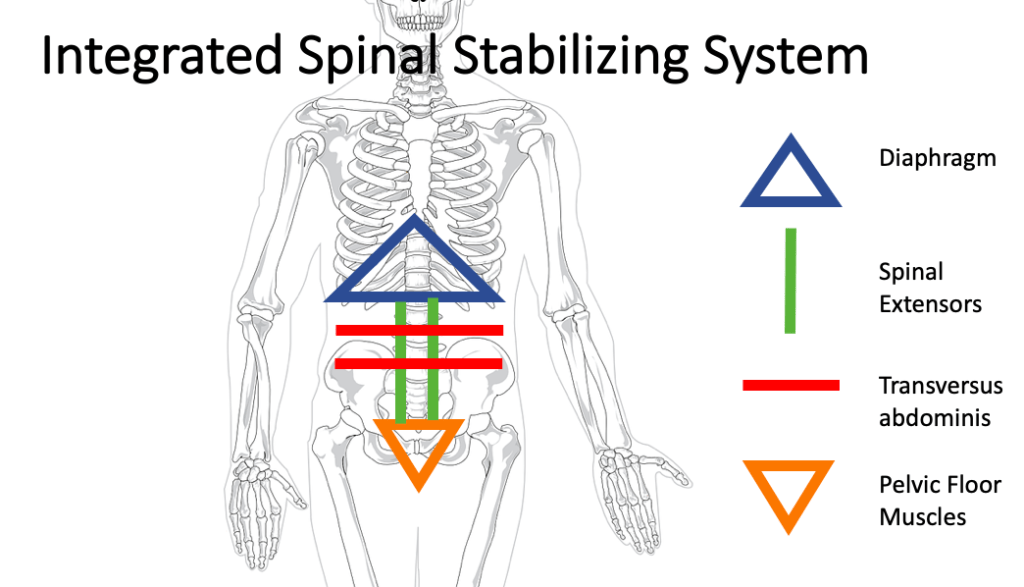Within the complex framework of our body’s operations, a subtle interplay unfolds—a harmonious coordination involving breath, core muscles, and the pelvic floor muscles. Recognizing the deep connection between intra-abdominal pressure, core muscle strength, and pelvic floor wellness is crucial for tapping into the capabilities of a resilient and harmonized physique. This article aims to demystify the complexities of this relationship, shedding light on how conscientious breathing and core activation, and pelvic floor muscles play a role in promoting an integrated spinal stabilizing system.
Intra-Abdominal Pressure (IAP): The Silent Force
At the center of this physiological symphony is intra-abdominal pressure—the pressure within the abdominal cavity exerted by the organs, notably the diaphragm, abdominal muscles, and pelvic floor. When harnessed effectively, IAP becomes a powerhouse that supports our spine, stabilizes our core, and ensures optimal functioning of our organs.
Core Muscles: The Stabilizing Guardians
The core muscles, including the transverse abdominis, rectus abdominis, obliques, and multifidus, work in unison to provide stability and protect the spine. Activating these muscles helps maintain proper posture, prevent lower back pain, and contribute to overall functional movement.

Breathing: A Symphony of Life
The diaphragm, our primary breathing muscle, plays a pivotal role in the delicate balance between inhaling and exhaling. Proper breathing not only ensures optimal oxygenation but also influences the rise and fall of intra-abdominal pressure. Diaphragmatic breathing, where the diaphragm fully contracts and descends during inhalation, contributes to a more effective engagement of core muscles.
Pelvic Floor Muscles: The Foundation of Support
The pelvic floor, a group of muscles situated at the base of the pelvis, forms a critical component of the core. These muscles support the pelvic organs, maintain continence, and contribute to sexual function. Balancing intra-abdominal pressure is crucial for pelvic floor health, as excessive pressure can lead to issues such as pelvic organ prolapse and incontinence.
The Symbiotic Relationship:
Inhalation and Core Engagement: During inhalation, the diaphragm descends, creating an increase in intra-abdominal pressure. Simultaneously, the core muscles engage to stabilize the spine and prevent excessive pressure on the pelvic floor.
Exhalation and Pelvic Floor Relaxation: Proper exhalation involves the controlled release of air, allowing the diaphragm to ascend. This controlled release prevents a sudden increase in intra-abdominal pressure and allows the pelvic floor muscles to relax.

Practical Tips for Optimal Functionality:
Mindful Breathing: Practice diaphragmatic breathing, allowing the belly to expand on inhalation and contract on exhalation. This promotes a harmonious relationship between breath and intra-abdominal pressure.
Core Strengthening Exercises: Incorporate exercises that target the core muscles, such as planks, bridges, and pelvic tilts, into your routine.
Pelvic Floor Exercises: Include pelvic floor exercises (Kegels) to enhance awareness, strength, and flexibility in these muscles.
Posture Awareness: Maintain good posture throughout the day to support the natural alignment of the spine and reduce unnecessary stress on the core and pelvic floor.
In the ballet of breath, core engagement, and pelvic floor muscles, each movement is interconnected, influencing the others in a delicate yet powerful symphony. By fostering an understanding of intra-abdominal pressure and cultivating mindful breathing and core strength, we empower ourselves to move through life with grace, resilience, and a foundation of optimal well-being. It’s a dance that begins with the breath within—a dance that, when mastered, leads to a life of strength, balance, and vitality.

